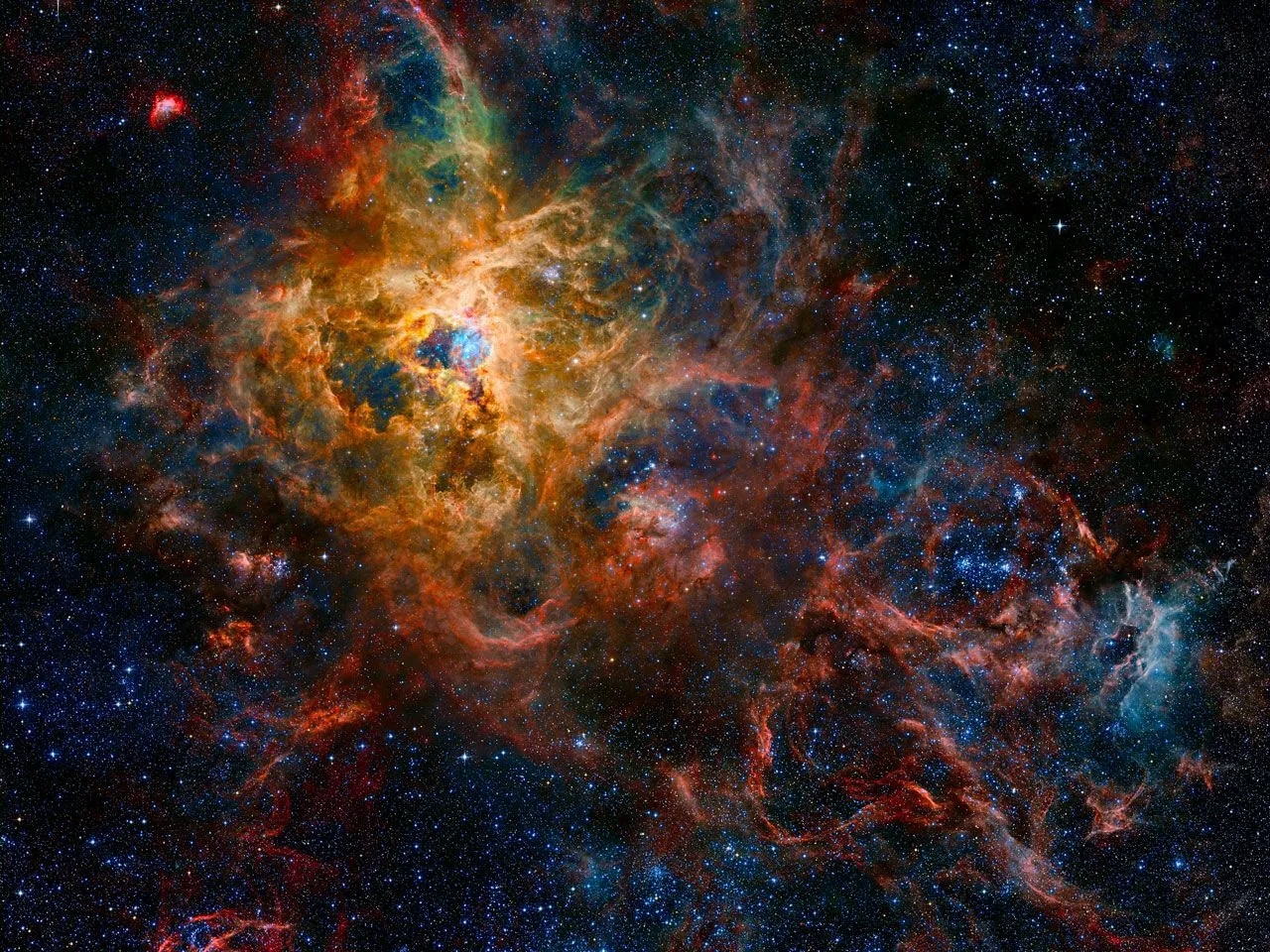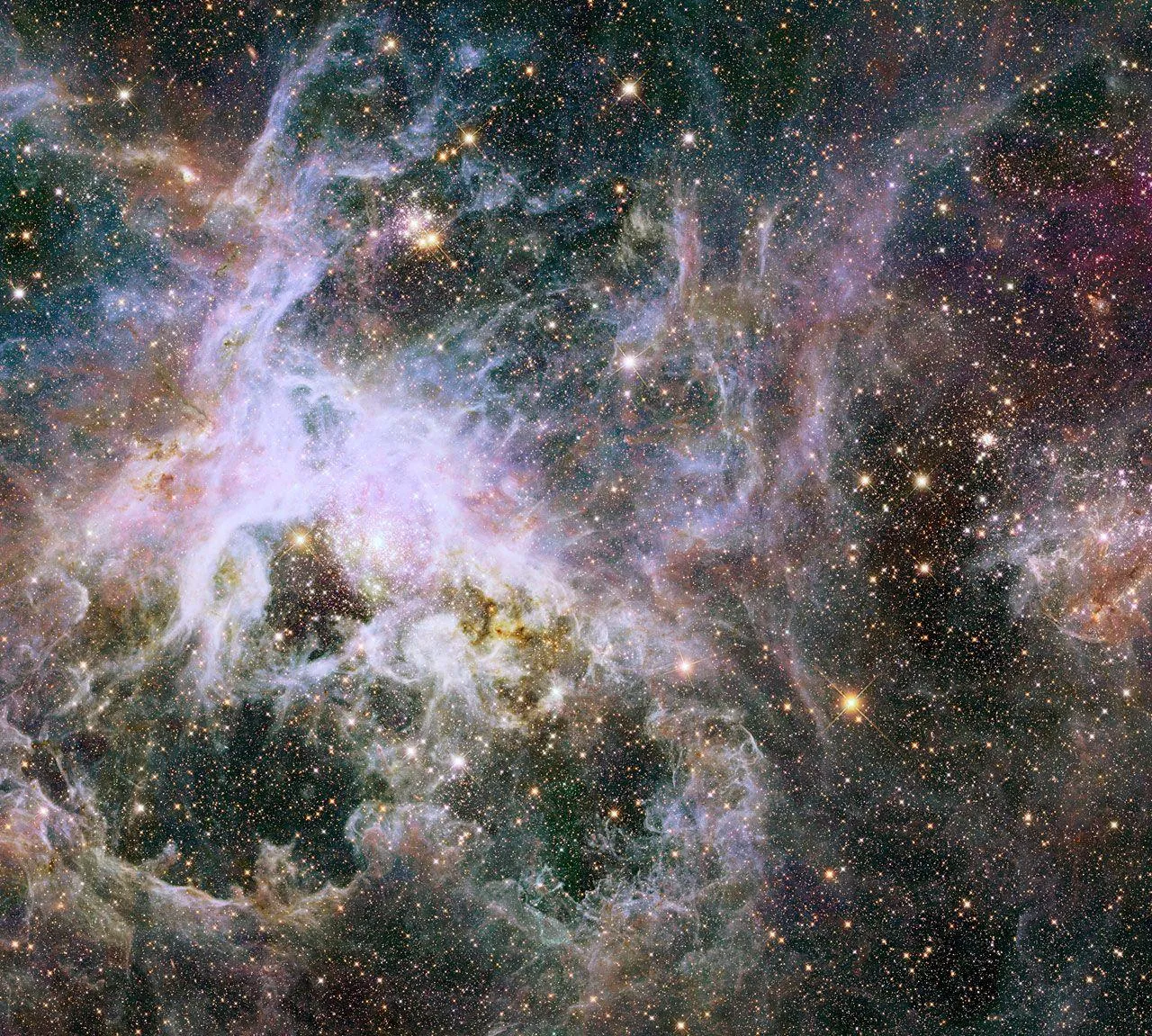What is the Tarantula Nebula
The Tarantula Nebula, also known as 30 Doradus, is a vast and vibrant star-forming region located in the Large Magellanic Cloud (LMC), a satellite galaxy of the Milky Way. It’s a celestial marvel, a cosmic cloud of gas and dust where new stars are born. Named for its spidery appearance in early telescope observations, the Tarantula Nebula is a spectacular sight for astronomers and a popular subject for breathtaking artwork. This nebula is not just beautiful, it’s also immensely important for understanding the processes of star formation, galaxy evolution, and the life cycles of stars. Its sheer size and the energetic processes within make it a unique laboratory for studying the universe.
The Tarantula Nebula’s Location in the Universe
To understand where the Tarantula Nebula is situated, we need to look beyond our own galaxy. The LMC, where the Tarantula Nebula resides, is a dwarf galaxy that orbits the Milky Way. This means it’s far outside the immediate vicinity of our solar system. The LMC is visible from the Southern Hemisphere, appearing as a hazy patch in the night sky. Locating the Tarantula Nebula within the LMC places it at a significant distance, offering a view into a region with a different galactic environment compared to our own. The vast distance also provides a different perspective on stellar evolution, allowing astronomers to observe the lifecycle of stars in a unique setting.
How Far Away is the Tarantula Nebula?

The Tarantula Nebula is approximately 160,000 light-years away from Earth. This immense distance means that the light we see from the nebula today originated 160,000 years ago. This incredible distance makes it a challenge to study, but it also provides a look back in time, allowing us to see how stars formed and evolved in a different era of the universe. Determining the exact distance is crucial for understanding the nebula’s physical properties, such as its size, mass, and the energy output. The distance is calculated using various methods, including parallax measurements and the study of Cepheid variable stars within the LMC. Knowing the distance allows us to measure the actual size and brightness of the nebula, providing crucial insights into its structure and activity.
Key Features of the Tarantula Nebula
The Tarantula Nebula is defined by a few key characteristics that set it apart. Its structure is dominated by the presence of massive young stars, intense radiation, and powerful stellar winds that sculpt the surrounding gas and dust. At the heart of the nebula is the star cluster R136, home to some of the most massive and luminous stars known. The intense ultraviolet radiation emitted by these stars ionizes the surrounding hydrogen gas, causing it to glow with a characteristic red hue. The nebula also has complex structures like filaments, bubbles, and dark lanes, resulting from the interplay of stellar winds, radiation pressure, and the nebula’s own gravitational forces.
The Tarantula Nebula’s Massive Size
The Tarantula Nebula’s enormous size is one of its most impressive features. It spans over 1,000 light-years in diameter, making it one of the largest known star-forming regions in the Local Group of galaxies. This vast expanse encompasses a huge amount of gas and dust, enough to create millions of stars. Its size allows astronomers to study various star formation processes in a single location. The sheer scale of the nebula provides opportunities for the simultaneous observation of numerous stellar nurseries, including the areas where stars are just beginning to form. The large size also contributes to the nebula’s brightness, making it a visually stunning object.
The Presence of Hot, Young Stars

The Tarantula Nebula’s stellar population is dominated by hot, young stars. The central star cluster R136 contains some of the most massive and luminous stars known. These stars, with masses dozens or even hundreds of times greater than our sun, emit a tremendous amount of energy, primarily in the form of ultraviolet radiation. This intense radiation ionizes the surrounding hydrogen gas, causing the nebula to glow. The powerful stellar winds from these stars also have a huge impact, shaping the structure of the nebula. The presence of these hot, young stars is a defining characteristic that makes the Tarantula Nebula a vibrant and active star-forming region, constantly evolving.
The Tarantula Nebula’s Stellar Nursery
The Tarantula Nebula is a thriving stellar nursery, where new stars are born. Inside its dense clouds of gas and dust, gravity causes these clouds to collapse, triggering nuclear fusion and igniting new stars. The nebula provides ideal conditions for star formation, including a rich supply of raw materials like hydrogen, helium, and dust particles. The process of star formation is continuous, with new stars appearing all the time. The youngest stars are still embedded in their natal clouds, while the older stars have already emerged, creating the stunning and complex structures observed in the nebula. Astronomers use the Tarantula Nebula to study the complex processes of how stars are formed, from the earliest stages to the final stages.
Formation of New Stars
The formation of new stars within the Tarantula Nebula is a dynamic process driven by gravity. In the densest parts of the nebula, gravity causes clouds of gas and dust to collapse under their own weight. As the cloud collapses, it heats up and spins faster. This process eventually leads to the ignition of nuclear fusion in the core of the collapsing cloud, marking the birth of a star. The stellar winds from the forming stars and the radiation pressure carve out cavities and trigger the collapse of surrounding materials, leading to the birth of even more stars. The Tarantula Nebula is a perfect location to observe the lifecycle of stars, from formation to their eventual end.
The Role of Gas and Dust

Gas and dust play a critical role in the Tarantula Nebula. The gas, mostly hydrogen, acts as the raw material for star formation. The dust particles are tiny grains of carbon and other elements, which also play a crucial role in this process. These dust particles help cool down the collapsing clouds of gas, which allows the clouds to fragment and form stars. The dust also absorbs and re-emits the radiation from the stars, creating beautiful and complex structures. The interplay between gas, dust, and radiation helps create the dynamic and visually stunning features of the Tarantula Nebula. The density and distribution of the gas and dust also affect how and where stars form within the nebula, leading to a diverse stellar population.
The Tarantula Nebula’s Supernova
The Tarantula Nebula is also famous for hosting Supernova 1987A, a supernova that occurred in 1987. Supernovas are powerful stellar explosions that mark the end of the life cycle of massive stars. The Supernova 1987A was one of the closest and most visible supernovas in modern history, giving astronomers a unique opportunity to study this phenomenon in detail. This event played a key role in understanding the nature of supernovas, stellar evolution, and the distribution of elements in the universe. The study of the supernova provides insights into the life cycle of massive stars and how they enrich the universe with heavy elements created in their cores. This supernova continues to provide data to this day.
The Remnant of Supernova 1987A
Supernova 1987A left behind a spectacular remnant, which is still visible today. The remnant is a ring-shaped structure of glowing gas, caused by the shockwave of the explosion expanding outwards. This expanding cloud of gas is interacting with the surrounding interstellar medium, creating complex and beautiful patterns. Studying the remnant allows astronomers to study how a supernova interacts with its environment. The observations of the remnant have provided key insights into the physics of supernovas and their impact on their environments. The continuing study of the remnant helps us understand how heavy elements are dispersed through space and how they contribute to the formation of new stars and galaxies.
Impact on the Nebula

Supernova 1987A had a significant impact on the Tarantula Nebula. The explosion released a tremendous amount of energy, radiation, and material into the surrounding environment, enriching the nebula with heavy elements created in the core of the exploding star. The shockwave from the supernova compressed the surrounding gas and dust, potentially triggering new star formation. The supernova also changed the overall appearance of the nebula, adding to its dynamic and evolving nature. The event provided a dramatic demonstration of the influence of massive stars on their surroundings, including their contribution to the formation of new stars.
Why is the Tarantula Nebula Important?
The Tarantula Nebula is a vital area for astronomical studies for many reasons. It provides astronomers a unique opportunity to study the process of star formation, the evolution of massive stars, and the impact of supernovas on the surrounding environment. Its proximity allows detailed observations using advanced telescopes, which in turn, enables scientists to study the physics of star formation and the lifecycles of stars. The nebula is also crucial for understanding galaxy evolution. The nebula also serves as a reference to understand star formation in other galaxies, which has wide implications for the evolution of the universe.
In conclusion, the Tarantula Nebula is a stunning celestial object that continues to reveal its mysteries. From its location in the Large Magellanic Cloud, through its features and the star formation taking place, it is a place of great interest to scientists. Its massive size, hot, young stars, and the impact of Supernova 1987A all make it a fascinating area of study. The Tarantula Nebula will continue to inspire awe and provide invaluable insights into the workings of our universe.
